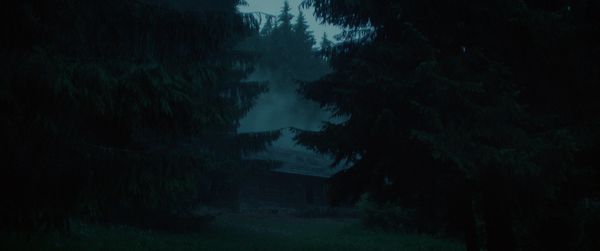 |
| Nightsiren Photo: courtesy of Tereza Nvotová |
A woman’s attempt to clean up the home of her recently deceased, abusive mother and deal with her feelings about the loss of her sister bring her into conflict with villagers who believe she is a witch in Tereza Nvotová’s atmospheric genre-bender Nightsiren, which recently screened as part of the 2023 Glasgow Film Festival. It’s a powerful tale which addresses a rising tide of misogyny in Slovakia, and for the Prague and New York-based filmmaker it was a journey of discovery, as she came face to face with deep rooted suspicions as important to people today as they were in Medieval times. They didn’t just reference witches in a metaphorical way, but believed that they really existed and were active in the world.
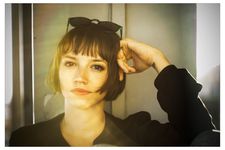 |
| Tereza Nvotová Photo: courtesy of Tereza Nvotová |
“For us it was really surprising that in modern Slovakia people still believe in that, but they really do,” she says. “I mean, it's not surprising for me that people believe in all kinds of magical stuff because that's kind of everywhere, but that they believe, specifically, in witches, it's like, ‘Okay, wow.’ And then we started to research more, and there was even a case of this guy who killed a woman a few years ago because he believed she was a witch. So this has some serious consequences too. And it is not surprising in terms of the misogyny in our country, and how that is connected with all these beliefs and traditions. It just makes perfect sense.
“If you look at the legislative part of our country, rapists, for example, are not really punished by law, because it's really, really hard, if you're a victim, to prove that it happened to you. There was a huge push back on the Istanbul agreement that was proposed by European Union to protect the victim – women are most of the victims of home violence and sexual violence in Slovakia. It was funny, because because the way it's called the Istanbul agreement, they thought it's like somehow connected with Islam. That's why the majority of people thought ‘Oh, this is some terrorist law or something.’ That was one reason and the second one was like, ‘Why are you telling us how we should behave with women? We know better.’ This law was purely protecting the victims, but in Slovakia, it had this huge pushback, even in Parliament.”
I ask her how the story developed, and she says that Barbara Namerova, the principal scriptwriter, discovered an anthropological book whose title translates into English as The Enemy Within, because witches are always within society.
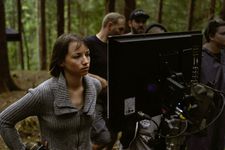 |
| Tereza Nvotová on set Photo: courtesy of Tereza Nvotová |
“She thought of setting the story in a place that we both know very well, and it's our cabin in the woods, because our fathers were classmates in high school. Slovakia has five million people, so it's like everyone knows everyone. And so our fathers, they were classmates, and that was during the communism times. They were part of these ecological groups that were trying to protect the villages. There are these wooden houses in the woods that were being ruined, and these guys from the city were trying to buy them to preserve them in their traditional form. So their whole group of high school classmates bought this, and they were going there and it was a safe haven from all the state regulations and everything because there is no electricity or running water.
“They were dragging us up there since we were like babies, so we know that place very well. And also, we learned that the last person who actually lived there in this wooden cabin was this woman called Otyla, and that's why we use that character. Although we know very little about her, I have her picture. She refused to live with the villagers. They thought she was completely crazy, they really had some prejudice going on against her. And then they told me that they took her to the psychiatric hospital where she probably died. But when you ask the villagers now, they don't really want to talk about her.”
There’s a moment in the film where a group of local teenagers go up to the cabin which the heroine, Šarlota, is trying to clean, and dare each other to approach it. It strikes me that in most horror films they would be the heroes, threatened by some dangerous presence in a cabin in the woods, but here the situation has been turned around.
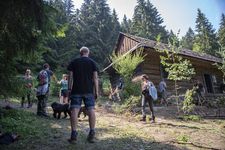 |
| The cabin by day Photo: courtesy of Tereza Nvotová |
“Oh, thank you. I'm really glad that you saw it this way!” she says. “That was very conscious, because me and Barbara, we like movies about witches and everything, but it's always kind of irritating that it is just narrating the same way. Even The Witch, which is a great movie, but in the end it's like, yeah, okay, the witches are existing, great, you know, like, there's evil. That same path is kind of boring to me right now. What we wanted was to turn it around and really show the ‘witches’ from their own perspective, not from the perspective of the people who believe in witches.”
They developed it in an international script lab, she says, and the feedback from people outside Slovenia made it clear that they thought it was set in the past, so she was careful to include scenes in which we see the motorway and other little indications that it’s happening in the present day.
“It was also very natural, because the way we wrote the movie was with this village in mind, and this setting in mind, because we know it so well, that there was no like, ‘Oh, I have to show the freeway’ or ‘I have to show the mobile phone mast’ or these ATVs they're driving. There are kids driving these crazy ATVs and I hate them, because they really ruining the natural environment and doing terrible harm to animals. So this is very much coming from the reality that people live there.”
Were there a lot of challenges involved in getting equipment to the location?
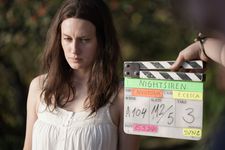 |
| Natalia Germani prepares for a scene as Šarlota Photo: courtesy of Tereza Nvotová |
“We didn't really shoot in the cabin that I was telling you about because I didn't want to burn it,” she says.” And the second reason was that it really is a more than 100 year cabin, and I really like to go there still. So we were looking for a location that will be similar, that will have this huge pine trees. For me, it's such a different visual if we put the house into the pine trees. It has much more atmosphere than just normal trees. And then in the end, we found a great location that was actually very nearby my cabin, like two hours walking from there. But we could approach it from a different side, and there was a road we could take with the cars without ruining the forest or anything, which is also very important to me, not to be this kind of filmmaker who comes somewhere and then everything is just destroyed. I was trying to make this movie the way that when we leave, it's going to look the same as it used to be before. So yeah, we found really nice place very close there.”
I ask if she had support from the local people, because I wasn’t sure that they’d like the way that people in their position are portrayed. She admits that she was initially nervous about approaching them.
“That's why we renamed the village in the movie. I was trying to explain to them, this is not about this particular village, this is about Slovakia. This is a fictional movie, not a documentary.” It worked out well, she reveals.
 |
| The village Photo: courtesy of Tereza Nvotová |
“There are scenes where the villagers were acting, because I like to use non actors when I can and I thought also it just adds so much more authenticity to the movie if I use the locals. They loved it. They really wanted to be there. So for example, when Šarlota, the main character, goes to the city office and there's two women who tell her that the mayor is not there, they're local. During the Midsummer Night festivities, they were local. Basically all of the extras plus the small parts were locals.
“I promised them that I will show the movie to them before the première. We came there, we spent the night at the cabin, and the next day we were having screening in the local cultural building. They made it such a happening, you know? There were two groups of folk singers – one was younger women, one was older women – and then there was the movie, and then we talked with them. And it was great. There was like, of course, a lot of drinking, and some people had to be carried out because they couldn't walk. But they they liked the movie.
“The paradox is that after they actually saw this movie, they came to me and they started to tell me all these stories they have with witches. I was like, ‘Oh my God,’ and they were like, ‘Yeah, there were witches in this village, but they are dead now.’ And I was like, ‘Yeah, and did they pass their witch-hood to someone else?’ Because usually they believe it's passed on. And they were like, ‘Yeah, we know who, but we can't tell you.’ They see the movie and still, they just continue in the same thing.”
 |
| Superstitions linger in Nightsiren Photo: courtesy of Tereza Nvotová |
Although she’s not taking the usual approach to the subject of witchcraft, she still makes use of the visual language of horror films. i ask her where that came from.
“I didn't have like one thing that was my inspiration but I was inspired by a combination of stuff,” she says. “Even stuff that Carlos Reygadas is doing with Post Tenebras Lux. He has these super authentic scenes there with locals and it looks like a documentary. And then all of a sudden you have the Devil walking in the room, you know? I was like, ‘Wow, you can really combine genres in such a way that I have never seen before.’ Also, as I mentioned, The Witch, or Border, that was something where they combined a very authentic drama story with a crazy troll mystery.
“I knew from the beginning that I will be on the edge of the genres. I want to be playful. For me, this movie is all about freedom, whether freedom in society or inner freedom in ourselves. I thought that, because of that, this movie needs to be free.” She shrugs. “It's really easy to say right now when it's finished, but it was super hard to get there because this was super new to me. I was trying to somehow find it out. That's why the editing process took me a year or something. It took me time to free myself to think in terms of combining these genres. It's like you're trying not to play by rules, but you still have to figure out what the rules are. So that was a crazy, crazy process, but I loved it.”
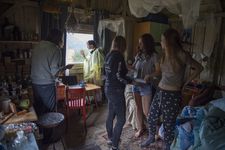 |
| Inside the cabin Photo: courtesy of Tereza Nvotová |
The young Šarlota has a traumatic experience at the start with her sister. i suggest that after that, it might be hard for her to be sure where reality begins and ends.
“Yeah,” she nods. “Trauma is is like a horror that happens to you, right? Like it's this horror scene that that stays in you and never leaves you alone. Or at least for me. And for her, coming back to this place where this whole thing happened is like going back to that horror that she's been in and trying to figure out what that was.”
Originally the film started ery differently, she explains. “But I realised I really need to show her starting point for the audience to go with her, because I want to be more subjective. We feel what she feels, we're trying to figure out what she's trying to figure out, I have friends who have been through trauma, and some of them would even not remember their own trauma, it's this crazy thing where your brain pushed some parts away. For her, in the movie, she only knew what she knew, but she didn't know what happened to her sister or anything else. So that was another research she was trying to figure out. It's partially a detective story in a way. And the places where these flashbacks go, where they reveal what happened, that was really tough for me to find out. They were everywhere in the movie throughout the editing process, until I figured where they should be.”
How does she feel about the film being screened at the Glasgow Film Festival?
 |
| Natalia Germani in Nightsiren Photo: courtesy of Tereza Nvotová |
“I'm really happy,” she beams. “I know it’s a common thing to say, but honestly, the process is super hard for me, because I felt sometimes unsure about where this whole thing was going. I'm just engaged with this film and I know I have to make it the best I can. That was one drive that I have. And the other one is always like this other part of me, which was always thinking ‘Oh, maybe this is not going well,’ or ‘It's never going to go well.’ Also, with the people I was working with, there were all sorts of dialogues about what this movie should be, and it's really hard to talk to your partners or co-producers because somehow they have their own idea of what the movie is so.
“The success of the movie and the fact that we won in Locarno, and then it had this really great circle around the festivals, and now it was brought to North America and German territory, just made me feel like ‘Wow, okay, I didn't fuck up. Good.’”





















